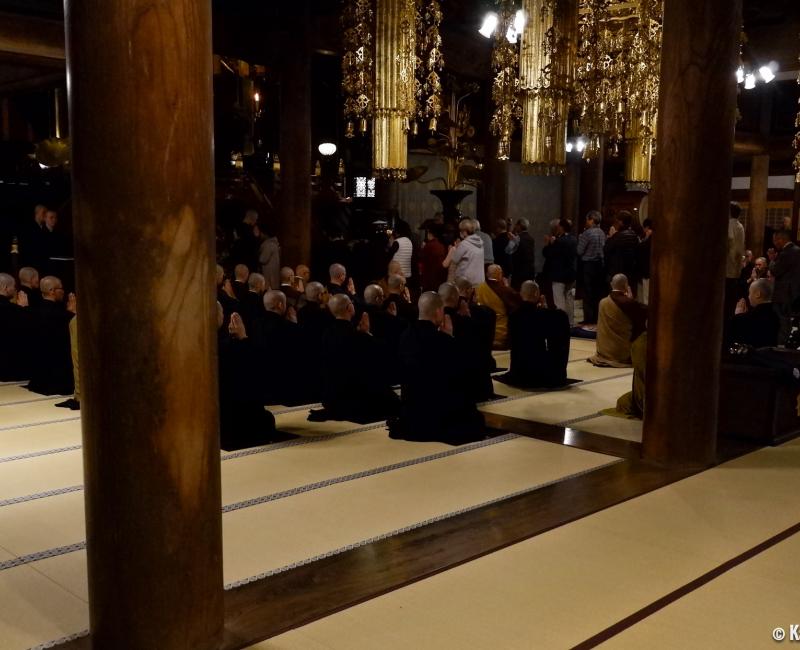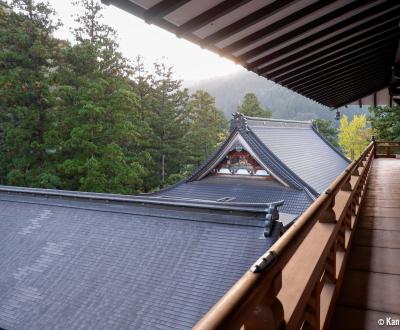Eihei-ji
The Zen Meditation Temple in Fukui
Eihei-ji is a Buddhist temple of the Soto Zen school located in the eponymous village, in Fukui prefecture in Japan. Secluded in the heart of a century-old cedar forest in the mountains, the complex is the ideal place for a short monastic retreat to practice meditation and Zazen.
Eihei-ji temple (literally "the temple of eternal peace") is not a place that one visits by chance. Far from the usual sightseeing itineraries, it is a true hidden treasure that wonders visitors thanks to its beauty, its outstanding architecture in the midst of the nature and the Zazen meditation experience (zazen means "just sitting") to share with the two hundred monks living here all year long.
Eihei-ji was built in 1244 by monk Eihei Dogen, who was the founder of a then new Soto Zen Buddhism current. Dogen developed his modern thinking after a long travel in China and his enlightening encounter with master Nyojo. Back in Japan, he first returned to his native Kyoto and stayed in several temples of the city, before founding his own independent monastery, Kosho-ji temple that is now located in Uji. Dogen was perceived as an agitator regarding Japanese Buddhism and escaped an arson instigated by local monks. In order to peacefully continue his teachings, he decided to leave and consequently accepted the invitation of one of his disciples to join him in Echizen province (present days’ Fukui prefecture).
Eihei-ji’s complex is composed of nearly seventy buildings and monuments on a 330,000m² area, entirely built with wood from the neighboring forests. Most of the pavilions are connected with each other’s by covered corridors, which are however opened on the sides, allowing many wonderful views on the temple and the surrounding nature. The visit course includes some inside parts of the buildings (make sure to remove your shoes!). Some buildings however are for the monks’ exclusive use, but the part of the grounds freely allowed is nonetheless quite large.
The Sanmon gate is the entrance to the lower part of the compound. It is the place where prospective monks wishing to be integrated in the community must stand still for a day, even in the worst of winter, to take the time to ponder their choice and make sure they want to live at Eihei-ji. The temple’s monastic life is indeed one of the harshest in the country. Inside the precincts stands the Butsuden that shelters the three Buddha (past, present, and future), as well as the Sodo, a room dedicated to Zazen practice.
At the highest place of the site, after a long series of stairs, one can reach the impressive Hatto lecture hall. This vast room with a high ceiling is quite fresh and displays in its center the statue of Sho Kanzeon Bodhisattva sided by the two A-Un lions. Monks gather in this room at dawn for prayers and sutra reading during more than one hour. Lastly, next to the Hatto is the Joyoden where the ashes of monk Dogen, as well as some of his prominent successors, are buried.

Shukubo: the experience of staying at the temple
It would be a shame to travel so far and not stay at least one night alongside the monks. Eihei-ji temple offers a shukubo lodging service, named Sanro, that includes:
- Two typical vegetarian meals of shojin ryori cuisine,
- Two Zazen meditation sessions of forty minutes each (one in the evening and one in the morning),
- The opportunity to attend to the collective prayer at dawn in the large Hatto hall,
- A guided tour of the grounds to learn more about the site and the particularities of Soto Zen Buddhism.
The rooms for visitors have a minimal comfort but are rather large. Anyway, the night is short, and one doesn’t stay at the temple for the bedding. The curfew is at 9 p.m. to allow an early wake up (3 a.m. in summer and 4 a.m. in winter) and attend to the first prayer of the day before a meditation session. As an outsider, silence is required during the rituals as a mark of respect. Therefore, even during meals (except for the thanks before and after) and including during the common bath, it is important to stay quiet and immerse in the mystical character of the moment.
In early morning, after prayer and breakfast are done, the monks wearing their samue working clothes start tackling the daily tidy up of the temple in an orderly manner. It is rare to be able to watch them working so energetically and it offers a surprising contrast with their usually calm and peaceful postures during the rest of the day. Eihei-ji temple is certainly impactful on many levels, and one can’t help but feel transformed at the end of the stay.
On a side note, since late July 2019, the hotel 🏨 Hakujukan, at the entrance of the temple, offers a larger capacity to accommodate visitors looking for a Zen experience.


